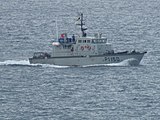
In naval terminology, a destroyer is a fast, maneuverable, long-endurance warship intended to escort larger vessels in a fleet, convoy, or carrier battle group and defend them against a wide range of general threats. They were originally conceived in 1885 by Fernando Villaamil for the Spanish Navy as a defense against torpedo boats, and by the time of the Russo-Japanese War in 1904, these "torpedo boat destroyers" (TBDs) were "large, swift, and powerfully armed torpedo boats designed to destroy other torpedo boats". Although the term "destroyer" had been used interchangeably with "TBD" and "torpedo boat destroyer" by navies since 1892, the term "torpedo boat destroyer" had been generally shortened to simply "destroyer" by nearly all navies by the First World War.
The United States Navy, United States Coast Guard, and United States National Oceanic and Atmospheric Administration (NOAA) use a hull classification symbol to identify their ships by type and by individual ship within a type. The system is analogous to the pennant number system that the Royal Navy and other European and Commonwealth navies use.
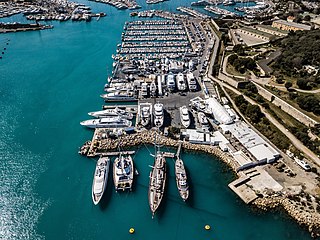
A shipyard, also called a dockyard or boatyard, is a place where ships are built and repaired. These can be yachts, military vessels, cruise liners or other cargo or passenger ships. Compared to shipyards, which are sometimes more involved with original construction, dockyards are sometimes more linked with maintenance and basing activities. The terms are routinely used interchangeably, in part because the evolution of dockyards and shipyards has often caused them to change or merge roles.

A patrol boat is a relatively small naval vessel generally designed for coastal defence, border security, or law enforcement. There are many designs for patrol boats, and they generally range in size. They may be operated by a nation's navy, coast guard, police, or customs, and may be intended for marine, estuarine, or river environments.
The Brazilian Navy is the naval service branch of the Brazilian Armed Forces, responsible for conducting naval operations.
Navantia is a Spanish state-owned shipbuilding company that builds vessels for the military and civil sectors. It is the fifth-largest shipbuilder in Europe and the ninth-largest in the world. The company is the result of the segregation of the military assets of the IZAR Group in 2005. The company designs, builds, and supports all types of surface vessels, submarines, and systems. In addition, it is diversifying into new markets such as renewable energy, the offshore industry, and naval services.

The Portuguese Navy is the naval branch of the Portuguese Armed Forces which, in cooperation and integrated with the other branches of the Portuguese military, is charged with the military defense of Portugal.
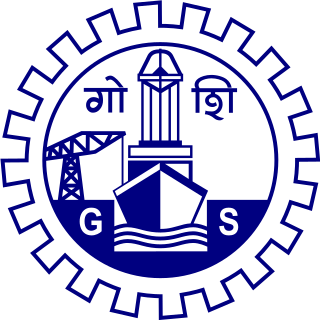
Goa Shipyard Limited (GSL) is an Indian Government owned ship building company located on the West Coast of India at Vasco da Gama, Goa. It was established in 1957, originally by the colonial government of the Portuguese in India as the "Estaleiros Navais de Goa", to build barges to be used in Goa's growing mining industry, which took off after the establishment of India's blockade of Goa in 1955. In the wake of Portugal's defeat and unconditional surrender to India following the 1961 Indian annexation of Goa, it was requisitioned to manufacture warships for the Indian Navy and the Indian Coast Guard.

The João Coutinho-class corvettes were a series of warships built for the Portuguese Navy for service in Portugal's African and Indian colonies. Initially rated as frigates, they were downgraded first to corvettes and then patrol vessels with age. They were designed in Portugal by naval engineer Rogério de Oliveira, but the urgent need of their services in the Portuguese Colonial War meant that the construction of the ships was assigned to foreign shipyards. Six ships were built; the first three ships were built by Blohm & Voss and the remaining three by Empresa Nacional Bazán. The ships were launched in 1970 and 1971. The relative cheap cost of the design led to it being the basis of several other classes in other navies. From 1970 until the end of the conflict in 1975, the corvettes were used for patrol and fire-support missions in Angola, Mozambique, Guinea and Cape Verde. After the African colonies gained their independence, the corvettes were assigned to patrol duties in Portuguese territorial waters.
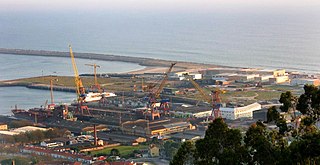
Estaleiros Navais de Viana do Castelo (ENVC) is a medium-sized shipyard in business since 1944, located in the town of Viana do Castelo, on the Atlantic Coast in the very north of Portugal. Occupying an area of 400,000 square metres and employing 625 people, it is a major Portuguese shipbuilder. In 2013 its assets and operations are sub-licensed to Martifer.

Gölcük Naval Shipyard is a naval shipyard of the Turkish Navy within the Gölcük Naval Base on the east coast of the Sea of Marmara in Gölcük, Kocaeli. Established in 1926, the shipyard serves for the building and the maintenance of military vessels. A total of 3,221 personnel are employed at the shipyard stretching over an area of 255,526 m2 (2,750,460 sq ft) with covered structures of 121,466 m2 (1,307,450 sq ft).

The Centauro-class patrol boat is a series of four patrol boats in service with the Portuguese Navy. It is an evolution of the preceding Argos class. This class is meant for fisheries inspection and control duties mainly in the Mainland Portugal shores – with some sporadic presence in the Madeira Archipelago. The Centauro class is Portuguese-designed and built at the Arsenal do Alfeite (Almada) and Estaleiros Navais do Mondego.
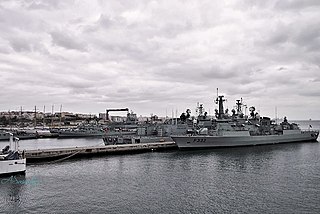
The Lisbon Naval Base, is the main installation and operational base of the Portuguese Navy. Located at the former Royal Estate of Alfeite on the south bank of the Tagus river's estuary, near the city of Almada, the installation is sometimes referred to as the Alfeite Naval Base.

The Tamandaré class are a class of future stealth guided-missile frigates for the Brazilian Navy, based on the MEKO family of ships. The project is being developed by the Ministry of Defence and the Águas Azuis consortium, composed of ThyssenKrupp Marine Systems (TKMS) and Embraer Defense & Security. The construction of the four planned frigates started in 2022 and are scheduled to be delivered between 2024 and 2028.

Thales Edisoft – Thales Edisoft Portugal, S.A. is a company of Thales Group that offers software development and engineering solutions, systems integration and technological consulting for critical systems in land, maritime, space or cyberspace for the defense and civil markets. Edisoft has currently partnerships with two portuguese shipbuilders, Arsenal do Alfeite and with West Sea Shipyard, the buider of Viana do Castelo-class patrol vessels.

Estabelecimento de Fundição e Estaleiros Ponta da Areia was one of the first shipbuilding industries in Brazil, having been founded by Charles Colman in 1844 and acquired in 1846 by Irineu Evangelista de Sousa, future Baron and Viscount of Mauá.


